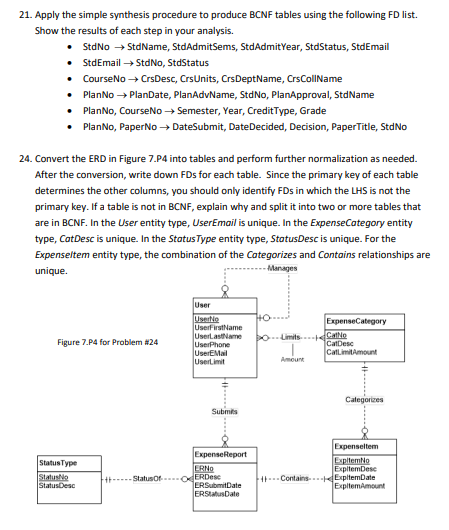

21. Apply the simple synthesis procedure to produce BCNF tables using the following FD list. Show the results of each step in your analysis. StdNo StdName, StdAdmitSems, StdAdmitYear, StdStatus, StdEmail . StdEmailStdNo, StdStatus . CourseNoCrsDesc, CrsUnits, CrsDeptName, CrsCollName . PlanNoPlanDate, PlanAdvName, StdNo, PlanApproval, StdName PlanNo, CourseNo Semester, Year, CreditType, Grade PlanNo, PaperNoDateSubmit, DateDecided, Decision, PaperTitle, StdNo 24. Convert the ERD in Figure 7 P4 into tables and perform further normalization as needed. After the conversion, write down FDs for each table. Since the primary key of each table determines the other columns, you should only identify FDs in which the LHS is not the primary key. If a table is not in BCNF, explain why and split it into two or more tables that are in BCNF. In the User entity type, UserEmail is unique. In the ExpenseCategory entity type, CatDesc is unique. In the Status Type entity type, StotusDesc is unique. For the Expenseltem entity type, the combination of the Categorizes and Contains relationships are unique. Manages User Limits Figure 7.P4 for Problem #24 Submits StatusType StatusNa -Statusof..ERDesc 21. Apply the simple synthesis procedure to produce BCNF tables using the following FD list. Show the results of each step in your analysis. StdNo StdName, StdAdmitSems, StdAdmitYear, StdStatus, StdEmail . StdEmailStdNo, StdStatus . CourseNoCrsDesc, CrsUnits, CrsDeptName, CrsCollName . PlanNoPlanDate, PlanAdvName, StdNo, PlanApproval, StdName PlanNo, CourseNo Semester, Year, CreditType, Grade PlanNo, PaperNoDateSubmit, DateDecided, Decision, PaperTitle, StdNo 24. Convert the ERD in Figure 7 P4 into tables and perform further normalization as needed. After the conversion, write down FDs for each table. Since the primary key of each table determines the other columns, you should only identify FDs in which the LHS is not the primary key. If a table is not in BCNF, explain why and split it into two or more tables that are in BCNF. In the User entity type, UserEmail is unique. In the ExpenseCategory entity type, CatDesc is unique. In the Status Type entity type, StotusDesc is unique. For the Expenseltem entity type, the combination of the Categorizes and Contains relationships are unique. Manages User Limits Figure 7.P4 for Problem #24 Submits StatusType StatusNa -Statusof..ERDesc








